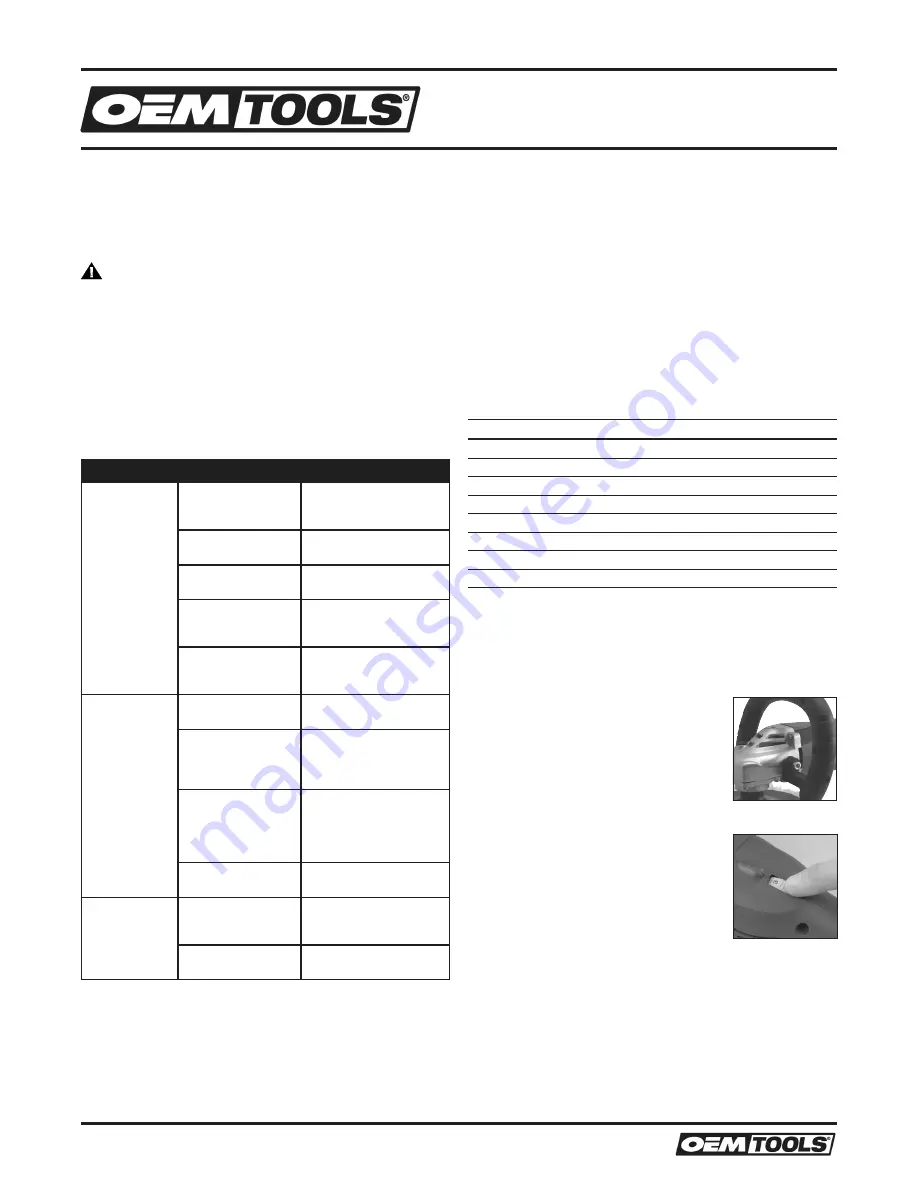
4
Operating Instructions and Parts Manual
24496
1/17
2017 OEMTOOLS
®
7" VARIABLE SPEED POLISHER
IMPORTANT SAFETY INSTRUCTIONS
The warnings, precautions, and instructions discussed in this
manual cannot cover all possible conditions and situations
that may occur. The operator must understand that common
sense and caution are factors which cannot be built into this
product, but must be supplied by the operator.
WARNING
Use only attachments recommended or sold by
manufacturer.
1. Do not disassemble the polisher. Take it to a qualified
professional when service or repair is required. Incorrect
reassembly may result in electric shock or fire.
2. Only use accessories which are specifically designed for
use with a 7" variable speed polisher.
3. Wear approved safety eye/face shield, ear defenders and
hand protection.
TROUBLESHOOTING
DISPOSAL
At the end of the useful life of the OEMTOOLS
®
7" Variable
Speed Polisher, dispose of the components according to all
state, federal and local regulations.
PURPOSE
Whether you are a professional detailer, or a weekend
DIY guy, the OEMTOOLS
®
Variable Speed Sander/
Polisher is up to the task. Featuring a soft start, this
sander/polisher comes equipped with a variable speed
dial that makes it easy to maintain the right speed to
avoid swirl marks and overheating the surface. RPM
range can be adjusted as low as 1,000 RPM all the
way up to 3,000 RPM. Plus, it has a common 5/8" x 11
spindle so you can attach a variety of accessories.
PRODUCT SPECIFICATIONS
Motor:
11 Amp
No-Load Speed:
1,000 – 3,000 RPM
Spindle Thread:
5/8" x 11
Spindle Lock:
Yes
Electronic Speed Control:
Yes
Variable Speed Control Dial:
Yes
Power Cord Length:
6 Ft.
Weight:
8 Lbs.
INSTRUCTIONS
SETTING UP
D-HANDLE GRIP
Using the included Screws and Hex Key
Wrench, attached the D-Handle to the
Gear Housing as shown. The D-Handle
can be installed for either right-hand or
left-hand use.
OPERATION
VARIABLE SPEED
1. The polisher is fitted with a variable
speed dial that allows the speed to be
adjusted to suit the application and
material.
2. The tool operates between the speeds
of 1,000 RPM and 3,000 RPM.
3. The higher the number on the variable
speed dial, the higher the speed.
4. For polishing and buffing applications it is recommended
that a lower speed (1,000-1,500 RPM) is used.
5. For sanding applications it is recommended that the
high speed (3,000 RPM) is used to provide efficient
material removal.
Trouble
Problem
Suggested Remedy
Sander/polisher
will not start
Power cord not
plugged in
Ensure that the cord is
connected to the power
supply
Power fault, fuse or
circuit breaker tripped
Check the power supply
Cord damaged
Use authorized service
center to repair or replace
Faulty switch
Use authorized service
center to repair or replace
switch
Faulty motor
Use authorized service
center to repair or replace
motor
Poor performance Extension cord too long
or undersized
Use extension cord heavy
enough to carry the current
Tool is overheating
Turn off the tool and let
it cool down to room
temperature. Inspect and
clean the ventilation slots
Too much wax on the
polishing sponge
Replace or clean the
accessory. Ensure that too
much polish is not applied
onto the accessory. Remove
a portion of wax and retry
Polishing bonnet or
buffing wheel worn
Replace with new bonnet or
buffing wheel
Vibration or
abnormal noise
Accessory not secured
Ensure that the accessory is
secured onto the spindle and
that all flanges are tight
Loose screws
Ensure that all fixing screws
are fully tightened


























